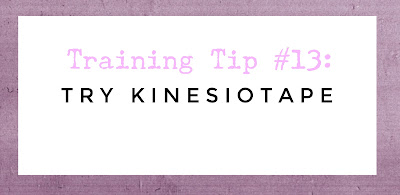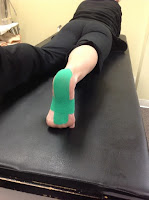What is Kinesiotape and how can it help?
You’ve probably seen it in the Olympics,
the “magic tape”, but what does it really
do?
the “magic tape”, but what does it really
do?
Kinesiotape is a multi-purpose tape that
physical therapists will sometimes use to aide in rehabilitation following an
injury. This tape can be used to assist muscle movements, inhibit other
muscles, reduce swelling, reduce scar tissue, and improve overall muscle function
and joint kinematics. Kinesiotape actually refers to a specific brand of tape,
but in reality there are several other brands that offer similar benefits-
Rocktape, and Bodytape for example. This type of tape offers much more mobility
than other kinds of more restrictive tape which can be used to stabilize
joints.
physical therapists will sometimes use to aide in rehabilitation following an
injury. This tape can be used to assist muscle movements, inhibit other
muscles, reduce swelling, reduce scar tissue, and improve overall muscle function
and joint kinematics. Kinesiotape actually refers to a specific brand of tape,
but in reality there are several other brands that offer similar benefits-
Rocktape, and Bodytape for example. This type of tape offers much more mobility
than other kinds of more restrictive tape which can be used to stabilize
joints.
There are several different taping
techniques that we use as physical therapists. If you have an area that is
really swollen following an acute injury, we can actually basket weave the tape
to assist with lymphatic flow. For this technique, you can cut the tape as
shown- with strips, or “tentacles”. I recommend cutting 6-8 strips/strands if
you’re using the wider (4 inch) tape, or 4 strips if you’re using the narrow (2
inch) tape. Find the area that is most swollen, and apply the tape with zero
stretch over this area. Avoid applying the tape to sensitive areas (behind the
knees, inner elbow, or face).
techniques that we use as physical therapists. If you have an area that is
really swollen following an acute injury, we can actually basket weave the tape
to assist with lymphatic flow. For this technique, you can cut the tape as
shown- with strips, or “tentacles”. I recommend cutting 6-8 strips/strands if
you’re using the wider (4 inch) tape, or 4 strips if you’re using the narrow (2
inch) tape. Find the area that is most swollen, and apply the tape with zero
stretch over this area. Avoid applying the tape to sensitive areas (behind the
knees, inner elbow, or face).
Here’s another technique we will
commonly use if you are having knee pain. This technique works to more so
stabilize your knee. You will need 3 strips of 2 inch tape for this technique. Cut
one strip to about 2 inches in length, and the other two to 4 inches in length,
then round the edges. Starting at the body area directly below your knee cap,
anchor one piece of tape with no stretch on the ends, then apply 50% stretch as
you encircle your patella on the inside. Repeat this procedure with your other
4 inch strip of tape, on the outside of your knee. For the final strip, you’re
going to want to apply 50% stretch to the middle portion of the tape, and apply
it directly below your patella.
commonly use if you are having knee pain. This technique works to more so
stabilize your knee. You will need 3 strips of 2 inch tape for this technique. Cut
one strip to about 2 inches in length, and the other two to 4 inches in length,
then round the edges. Starting at the body area directly below your knee cap,
anchor one piece of tape with no stretch on the ends, then apply 50% stretch as
you encircle your patella on the inside. Repeat this procedure with your other
4 inch strip of tape, on the outside of your knee. For the final strip, you’re
going to want to apply 50% stretch to the middle portion of the tape, and apply
it directly below your patella.
Another technique that we commonly use
in runners in this technique for plantar fasciitis/arch support. You will need
1 piece of 2 inch tape cut about 4 inches long, and 2-3 pieces cut 2-3 inches
long. With your foot flexed (toes pulled up towards your shin), tape from the
ball of your foot towards your heel. Then apply 2-3 strips at your arch. The
middle of the tape should be stretched to 50%, then no stretch on the ends. You
can also perform this taping technique (or have someone else help you) in a plank
position in order to get your toe involved.
in runners in this technique for plantar fasciitis/arch support. You will need
1 piece of 2 inch tape cut about 4 inches long, and 2-3 pieces cut 2-3 inches
long. With your foot flexed (toes pulled up towards your shin), tape from the
ball of your foot towards your heel. Then apply 2-3 strips at your arch. The
middle of the tape should be stretched to 50%, then no stretch on the ends. You
can also perform this taping technique (or have someone else help you) in a plank
position in order to get your toe involved.
What if you have sensitive skin?
Although skin irritation can happen, it is extremely rare. If you have
sensitive skin, it is possible for you to have some irritation from the tape,
but if this occurs gently take off the tape with soap and warm water.
Generally, we recommend that you take the tape off after 3-5 days of wear. If
you know you are usually sensitive to adhesives, you may want to actually take
the tape off sooner.
Although skin irritation can happen, it is extremely rare. If you have
sensitive skin, it is possible for you to have some irritation from the tape,
but if this occurs gently take off the tape with soap and warm water.
Generally, we recommend that you take the tape off after 3-5 days of wear. If
you know you are usually sensitive to adhesives, you may want to actually take
the tape off sooner.
Here are some general guidelines that
you should follow if using this tape:
- Wear the tape for 3-5 days maximum at a
time, if you have sensitive skin, you may want to wear for a shorter period of
time. - When removing the tape, do not just rip
it off, this may damage the underlying skin. Instead, hold the skin, and roll
of the tape. Soap and warm water, or baby oil can also be helpful in tape
removal. - You may wear the tape in the shower or
in the water- but if it gets wet do NOT blow dry the tape- this will activate
the tape and you could burn your skin. - If itching or discomfort occurs with the
tape, do not hesitate to take it off immediately. - It is OK to exercise and perform all
regular activities while you are wearing the tape. - If the skin surrounding the tape is
showing redness/irritation remove the tape immediately. - If the skin under the tape starts to
feel numb/tingly remove immediately. - Do not tape over numb areas or areas
with poor sensation. - Shoes/socks/other clothing can be worn
over the tape- never apply the tape over clothing. - Do not use tape over areas where you’ve
been treated with radiation, or if you have history of cancer without first
checking with your doctor. - Tape comes in different colors/patterns,
feel free to choose based on your color preference. The color and/or pattern of
the tape has no bearing on the strength or effectiveness of the tape.
As always, if you are unfamiliar with
taping, or are unsure if taping could benefit you, make sure you have a
physical therapist show you how to apply the tape properly. If you are taping
yourself, and you’re experiencing pain or itching- take it off!
taping, or are unsure if taping could benefit you, make sure you have a
physical therapist show you how to apply the tape properly. If you are taping
yourself, and you’re experiencing pain or itching- take it off!
How to Kinesiotape for Knee Pain
How to Kinesiotape for Foot Pain, Plantar Fasciitis & Arch Support
How to Kinesiotape for Swelling of the Foot
Blog post by Tiffany Sadeck.
About
Tiffany Sadeck PT DPT CSCS
Tiffany is a member of the Cape Cod
Rehab Running Team with a Doctor oh Physical Therapy degree. She is also a Certified Strength &
Conditioning Specialist with a long history of running which began her freshman
year of high school. A 3-season athlete,
Tiffany was captain her junior and senior year and went on to run Division 3
Cross Country and Track & Field at Springfield College. She competed in events ranging from the 800-2
mile and high jump. Tiffany began
running longer distances up to the marathon two years ago and would like to
help runners to help better times and meet goals while preventing injuries and
maintaining a fun, friendly training environment.
Rehab Running Team with a Doctor oh Physical Therapy degree. She is also a Certified Strength &
Conditioning Specialist with a long history of running which began her freshman
year of high school. A 3-season athlete,
Tiffany was captain her junior and senior year and went on to run Division 3
Cross Country and Track & Field at Springfield College. She competed in events ranging from the 800-2
mile and high jump. Tiffany began
running longer distances up to the marathon two years ago and would like to
help runners to help better times and meet goals while preventing injuries and
maintaining a fun, friendly training environment.







